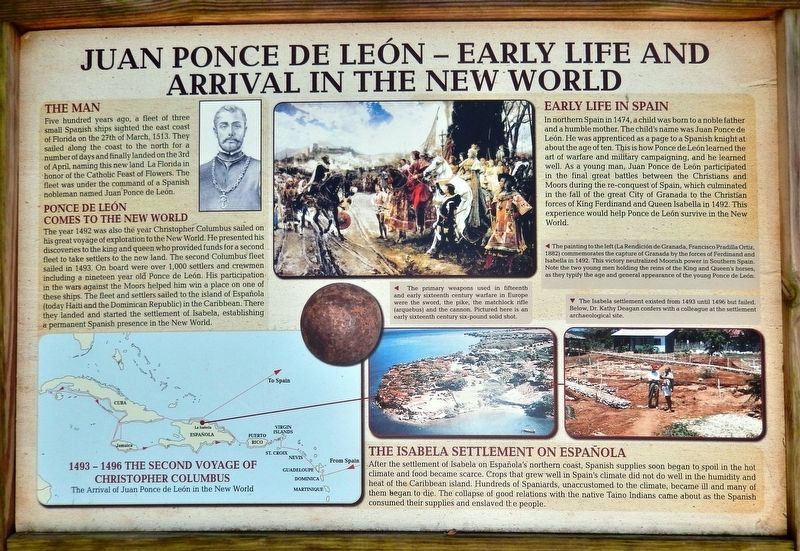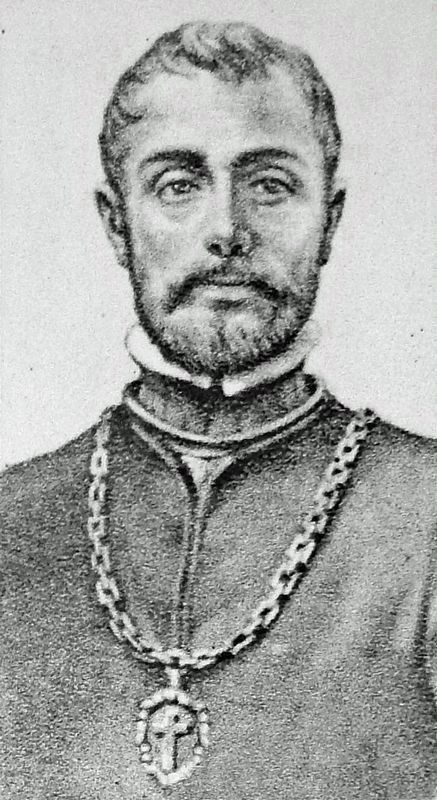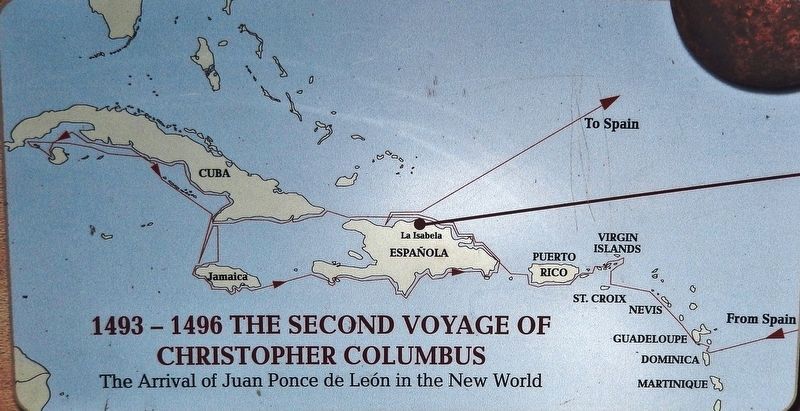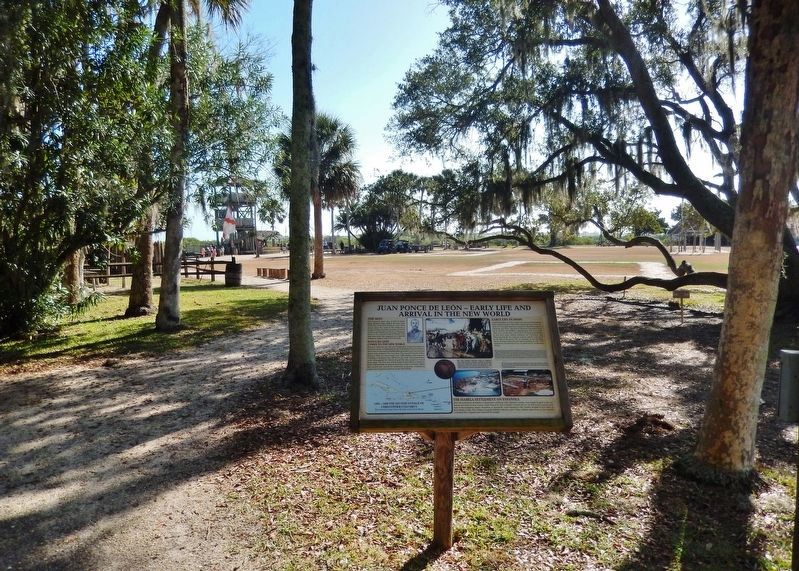Historic District in St. Augustine in St. Johns County, Florida — The American South (South Atlantic)
Juan Ponce De León
Early Life and Arrival in the New World
The Man
Five hundred years ago, a fleet of three small Spanish ships sighted the east coast of Florida on the 27th of March, 1513. They sailed along the coast to the north for a number of days and finally landed on the 3rd of April, naming this new land La Florida in honor of the Catholic Feast of Flowers. The fleet was under the command of a Spanish nobleman named Juan Ponce de León.
Ponce De León Comes to the New World
The year 1492 was also the year Christopher Columbus sailed on his great voyage of exploration to the New World. He presented his discoveries to the king and queen who provided funds for a second fleet to take settlers to the new land. The second Columbus fleet sailed in 1493. On board were over 1,000 settlers and crewmen including a nineteen year old Ponce de León. His participation in the wars against the Moors helped him win a place on one of these ships. The fleet and settlers sailed to the island of Espanola (today Haiti and the Dominican Republic) in the Caribbean. There they landed and started the settlement of Isabela, establishing a permanent Spanish presence in the New World.
Early Life in Spain
In northern Spain in 1474, a child was born to a noble father and a humble mother. The child's name was Juan Ponce de León. He was apprenticed as a page to a Spanish knight at about the age of ten. This is how Ponce de León learned the art of warfare and military campaigning, and he learned well. As a young man, Juan Ponce de León participated in the final great battles between the Christians and Moors during the re-conquest of Spain, which culminated in the fall of the great City of Granada to the Christian forces of King Ferdinand and Queen Isabella in 1492. This experience would help Ponce de Leon survive in the New World.
The Isabela Settlement on Española
After the settlement of Isabela on Española's northern coast, Spanish supplies soon began to spoil in the hot climate and food became scarce. Crops that grew well in Spain's climate did not do well in the humidity and heat of the Caribbean island. Hundreds of Spaniards, unaccustomed to the climate, became ill and many of them began to die. The collapse of good relations with the native Taino Indians came about as the Spanish consumed their supplies and enslaved the people.
[photo caption]
• The primary weapons used in fifteenth and early sixteenth century warfare in Europe were the sword, the pike, the matchlock rifle (arquebus) and the cannon. Pictured here is an early sixteenth century six-pound solid shot.
Topics. This historical marker is listed in these topic lists: Colonial Era • Exploration • Settlements & Settlers • Waterways & Vessels. A significant historical year for this entry is 1492.
Location. 29° 54.419′ N, 81° 18.857′ W. Marker is in St. Augustine, Florida, in St. Johns County. It is in the Historic District. Marker can be reached from Williams Street east of Magnolia Avenue when traveling east. Marker is located along the interpretive trail in Ponce de León's Fountain of Youth Archaeological Park. Touch for map. Marker is at or near this postal address: 11 Magnolia Avenue, Saint Augustine FL 32084, United States of America. Touch for directions.
Other nearby markers. At least 8 other markers are within walking distance of this marker. The Fountain of Youth (here, next to this marker); a different marker also named Juan Ponce De León (here, next to this marker); Juan Ponce De Leon (a few steps from this marker); a different marker also named Juan Ponce De León (a few steps from this marker); a different marker also named Juan Ponce De León (a few steps from this marker); The Matchlock Arquebus (within shouting distance of this marker); Continuing Archaeology (within shouting distance of this marker); Don Juan Ponce De Leon (within shouting distance of this marker). Touch for a list and map of all markers in St. Augustine.
Related markers. Click here for a list of markers that are related to this marker. Ponce de León's Fountain of Youth Archaeological Park
Also see . . . Juan Ponce de León.
Born in 1460 into a noble family in León, Spain, Juan Ponce served as a page in the royal court of Aragon. He later became a soldier, fighting in the Spanish campaign against the Moors in Granada. After that war ended, he may have gone along on the second voyage to the West Indies led by Christopher Columbus in 1493. Nearly a decade later, he was serving as a captain in the force commanded by Nicolás de Ovando, Spain’s royal governor of the island of Hispaniola (present-day Haiti and the Dominican Republic). After Ponce de León suppressed a mutiny by Indigenous Americans, Ovando rewarded him with the governorship of the eastern province of Hispaniola.(Submitted on December 21, 2021, by Cosmos Mariner of Cape Canaveral, Florida.)
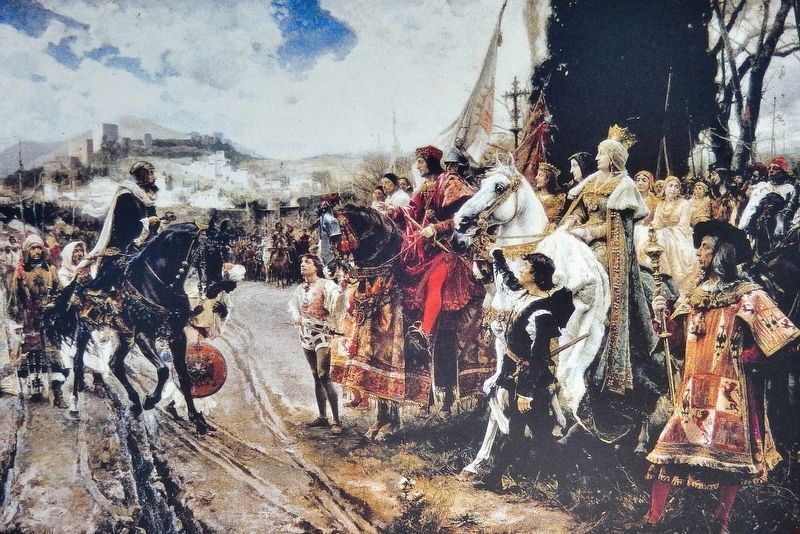
4. Marker detail: La Rendición de Granada, Fracisco Pradilla Ortiz, 1882
This painting commemorates the capture of Granada by the forces of Ferdinand and Isabella in 1492. This victory neutralized Moorish power in Southern Spain. Note the two young men holding the reins of the King and Queen's horses, as they typify the age and general appearance of the young Ponce de León.
Credits. This page was last revised on December 29, 2021. It was originally submitted on December 20, 2021, by Cosmos Mariner of Cape Canaveral, Florida. This page has been viewed 556 times since then and 95 times this year. Photos: 1, 2, 3, 4, 5, 6. submitted on December 21, 2021, by Cosmos Mariner of Cape Canaveral, Florida.
